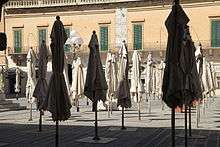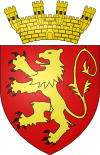Casa del Commun Tesoro
| Casa del Commun Tesoro | |
|---|---|
 Main entrance to the Casa del Commun Tesoro | |
| Former names | Grand Hotel |
| Alternative names | Casino Maltese |
| General information | |
| Status | Intact |
| Location | Valletta, Malta |
| Coordinates | 35°53′55.3″N 14°30′47″E / 35.898694°N 14.51306°E |
| Current tenants | Casino Maltese |
| Completed | c. 16th–17th centuries |
| Renovated | 1914 |
| Technical details | |
| Material | Limestone |
| Floor count | 2 |
| Renovating team | |
| Architect | Nicola Buhagiar and Francesco Sammut |
The Casa del Commun Tesoro (Italian for House of the National Treasury) is a building in Valletta, Malta, located in Republic Square facing the Bibliotheca. It was originally built to house the Treasury of the Order of St. John. Part of the building housed Malta's first post office, and over the years it was also used as government offices, a hotel and a cinema. Since the early 20th century, it has been the premises of a gentlemen's club known as the Casino Maltese.
History
The Casa del Commun Tesoro originally belonged to the Treasury of the Order of St. John, and it housed the Treasury's accounts, contracts and records.[1] Gold and silver bullion were stored at the Conservatoria, located opposite the Casa del Commun Tesoro. This building was demolished in the 1780s to make way for the Bibliotheca. The Treasury was headed by a Grand Commander, who was assisted by two Procurators of the Treasury, a Procurator of the Grand Master, a Conventual Conservator and a Secretary. The latter resided in an apartment within the Casa del Commun Tesoro.[2]

In 1708, Malta's first proper postal service was established, and a room within the Casa del Commun Tesoro became the island's first post office. The building continued to house the Packet Office until around 1841, when it was transferred to the Banca Giuratale. On 1 April 1849, the Island Post Office was also transferred from the Casa del Commun Tesoro to the Banca Giuratale, which later became known as the General Post Office.[3]
In the early 19th century, the British used the building for a number of public offices, including the Chief Secretary's Office, the office of the Collector of Land Revenue and the Government Treasury. English poet and writer Samuel Taylor Coleridge worked inside the building between 1804 and 1805. A plaque on the façade of the building was attached by Giovanni Bonello in the commemoration of Coleridge.[4] It was converted into a hotel in the late 19th century, known as the Grand Hotel.[5] At one point, part of the building also housed the second cinema to open in Malta, which was called the Grande Cinematografo or the Salinos Cinema.[6] Since the early 20th century, the building has housed the Casino Maltese, a reputed gentlemen's club.[1] The structure was extensively modified in 1914 by the architect Nicola Buhagiar.[2]
In April 1921, Japanese Crown Prince (later Emperor) Hirohito was received at the Casino Maltese, while visiting Malta as part of a six-month tour of Europe.[7][8] Hirohito presented a vase to the club, and this is still exhibited at the building.[9]
The building was severely damaged by aerial bombardment in World War II.[10] In 1942, the grand stairway was destroyed after a bomb fell in the building's courtyard, but it was later rebuilt.[1] At this point the building was redesigned, with several modifications, by Francesco Sammut.[11]
The building is scheduled as a Grade 1 national monument by the Malta Environment and Planning Authority.[1]
Architecture

The Casa del Commun Tesoro is a large building with two stories. The façade is somewhat plain, and an open balcony runs along most of the first floor. The façade facing Republic Street contains a large sundial and calendar, which is unique in Malta. Its ground floor contains a number of shops, including Caffe Cordina.[12] The interior of the building includes a decorated ceiling, a grand staircase and a central courtyard.[1]
Further reading
- "Club History". Casino Maltese. Archived from the original on 31 March 2016.
References

- 1 2 3 4 5 "One World – Protecting the most significant buildings, monuments and features of Valletta (2)". Times of Malta. 22 May 2008. Archived from the original on 4 March 2016.
- 1 2 Denaro, Victor F. (1959). "Houses in Kingsway and Old Bakery Street, Valletta". Melita Historica. 2 (4): 204–205. Archived from the original on 17 November 2015.
- ↑ "Maltapost privatisation latest red-letter day in postal history". Times of Malta. 21 January 2008. Archived from the original on 6 October 2015.
- ↑ Benoit, Marie (9 March 2014). "Marie Benoit's Diary". The Malta Independent. Retrieved 14 March 2016.
- ↑ 19th Century Hotels in Malta. pp. 115-116.
- ↑ Benoit, Marie (28 February 2014). Marie Benoit's Diary. The Malta Independent. Archived from the original on 10 October 2016.
- ↑ "Maltese community found in Japan dates back more than 100 years". The Malta Independent. 9 June 2015. Archived from the original on 14 August 2015.
- ↑ "Documentary on Maltese community in Japan". Times of Malta. 19 July 2015. Archived from the original on 9 March 2016.
- ↑ Bonello, Giovanni (2003). Histories of Malta – Convictions and Conjectures, Volume 4. Fondazzjoni Patrimonju Malti. pp. 217–218. ISBN 9789993210276.
- ↑ Manley, Deborah (2012). Malta: A Traveller's Anthology. Andrews UK Limited. p. 102. ISBN 1908493593.
- ↑ 200-year-old History in an old musty archive. 11 March 2012. The Malta Independent. Retrieved 3 July 2016.
- ↑ "The History". Caffe Cordina. Archived from the original on 24 September 2015.
